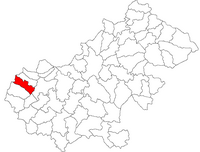Ciumeşti
|
Ciumeşti Shamagosch Csomaköz |
||||
|
||||
| Basic data | ||||
|---|---|---|---|---|
| State : |
|
|||
| Historical region : | Sathmar | |||
| Circle : | Satu Mare | |||
| Coordinates : | 47 ° 40 ' N , 22 ° 20' E | |||
| Time zone : | EET ( UTC +2) | |||
| Area : | 45.32 km² | |||
| Residents : | 1,407 (October 20, 2011) | |||
| Population density : | 31 inhabitants per km² | |||
| Postal code : | 447262 | |||
| Telephone code : | (+40) 02 61 | |||
| License plate : | SM | |||
| Structure and administration (as of 2016) | ||||
| Community type : | local community | |||
| Structure : | Ciumeşti, Berea , Viişoara | |||
| Mayor : | Ioan Schwarczkopf ( PCM-MPP ) | |||
| Postal address : | Str. Principală, no. 341 loc. Ciumeşti, jud. Satu Mare, RO-447262 |
|||
Ciumeşti ( German Schamagosch , Hungarian Csomaköz ) is a municipality in the Satu Mare district in the historical Sathmar region in Romania . The villages of Berea and Viișoara belong to the municipality of Ciumeşti .
Geographical location
Ciumeşti is located in northwestern Romania, 50 km from Satu Mare (Sathmar) and 13 km from Carei (Greater Karol) , near the border with Hungary .
history
In the Kingdom of Hungary , today's municipality belonged to the Nagykároly district in Sathmar County , then to the historical Sălaj district and, from 1950, to today's Satu Mare district .
The municipality of Ciumești emerged from the municipality of Sanislău (Stanislau) since 2004 .
population
The community had 1,407 inhabitants in 2011, most of whom were ethnic Hungarians . 258 of them described themselves as Germans , 127 as Romanians , 67 as Roma .
Attractions
In the community center the reformed church from the 15th century was renovated in the neo-Gothic style and the Roman Catholic church was built in 1856 and is a listed building.
archeology
The late Iron Age helmet of Ciumeşti was found on the territory of the municipality and is now in the National Museum in Bucharest . In addition, a Latène period burial ground was discovered on a dune on the outskirts in 1960 , which was excavated in 1962, 1964 and 1965 under the direction of V. Zirra. It contained seven body burials, 21 pit fire graves and four urn burials, three more cremations belong to the early Iron Age. A settlement with pit houses from the LtB2 period was discovered in the district of Bostănărie / Tökös . Furthermore Mesolithic findings known. On the area of the incorporated village of Berea . were Neolithic discoveries made.
Web links
- ghidulprimariilor.ro , Ciumeşti
- dgaspcsm.ro , Ciumeşti
- romanianhistoryandculture.com , helmet from Ciumești
Individual evidence
- ↑ a b 2011 census in Romania ( MS Excel ; 1.3 MB)
- ↑ Information from the Romanian Parliament accessed on September 7, 2018 (Romanian)
- ↑ Information on the Reformed Church in Ciumeşti at biserici.org, accessed on September 8, 2018 (Romanian)
- ↑ Information on the Roman Catholic Church in Ciumești at biserici.org, accessed on September 8, 2018 (Romanian)
- ↑ a b List of historical monuments of the Romanian Ministry of Culture, updated 2015 (PDF; 483 kB; Romanian)
- ↑ romanianhistoryandculture.com , helmet Ciumeşti
- ↑ Aurel Rustoiu, keyword Ciumeşti. In: Susanne Sievers, Otto H. Urban, PC Ramsl (Ed.), Lexicon for Celtic Archeology. Vienna, publishing house of the Austrian Academy of Sciences. Volume 1, AK, 357
- ↑ Aurel Rustoiu, keyword Ciumeşti. In: Susanne Sievers, Otto H. Urban, PC Ramsl (Ed.), Lexicon for Celtic Archeology. Vienna, publishing house of the Austrian Academy of Sciences. Volume 1, AK, 358


